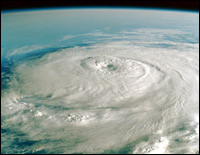As the world watched New Orleans’ devastating descent into squalor last week, questions about connections between global warming and hurricanes reemerged. A few politicians and activists leapt to offer their views, most of which were unmeritorious. So what does the science say?

Swifter, higher, stronger?
Investigations of the climatology of tropical cyclones (the generic name for the storms we call tropical storms or hurricanes in the Western Hemisphere) must be broken into at least two separate categories. The first involves storm formation: Is the number of storms changing with time? On a related note, do the regions of tropical cyclone genesis change with climate? The second involves intensity: Is the average or peak wind speed affected? What about a storm’s lifetime (the time from inception to decay or landfall)?
The first of these questions is easiest to answer. The number of storms is not increasing, and there is no theoretical basis to believe that it will. Globally, roughly 90 tropical cyclones form each year. This number has been remarkably stable for as long as a global record has existed — typically varying less than plus or minus 10 storms each year — though the physics that controls this number and its stability remains enigmatic (why 90 storms? why not nine? why not 900?).
Of greater importance to the United States and other nations in the Western Hemisphere is the small fraction of storms spawned in the Atlantic basin, which constitutes just 11 percent of the global total. With such comparatively small numbers, there is great year-to-year variability, much of which is well correlated with variables such as El Niño and African droughts. (It is these correlations that permit reasonable basin-wide seasonal forecasts months before the hurricane season begins; still, the physics behind these statistical relationships has been less thoroughly investigated.) During the past decade, the Atlantic has returned to an active period, which is believed to be part of a multi-decadal, natural oscillation.
One oft-stated misconception about climate change and hurricanes is that the region of tropical cyclone formation will expand with warming temperatures. Many meteorologists note that tropical cyclones rarely form in regions where the sea surface temperature is colder than 26 degrees C (78 degrees F). There is nothing magical about that temperature, however, and it’s a threshold that’s likely to be a function of climate. In truth, regions prone to tropical cyclone genesis are better characterized as areas in which air in the lowest layer of the atmosphere (the troposphere) is slowly ascending (that is, able to convect) — this is true in the tropics, but not in higher latitudes.
In our present climate, the region where this occurs is nearly collocated with the area of sea surface temperatures that exceed 26 degrees C. If a warmer climate causes the ocean and the atmosphere to warm in tandem, the ocean surface temperature considered to be the threshold for tropical cyclone formation will simply rise as well, and such formations will still be confined to the tropics. A poleward migration of 26 degree C waters does not mean that the regions in which tropical cyclones form would expand too. This point has been lost on many meteorologists.
While the number of storms and the regions in which they form appear fixed, there is some reason to expect modest increases in intensity with warming temperatures. We have a solid theoretical understanding of the maximum intensity that any storm may achieve; most never reach this upper limit, which is regulated by thermodynamics, but there are always some that do (Katrina being a recent example). Over a large enough sample, an average storm’s intensity is related to the upper theoretical limit. Thus, we can use changes in the maximum potential intensity as a guide for how an average storm will respond.
All else being equal (a limiting assumption), for every 1 degree C (2 degrees F) increase in sea surface temperature, there is a 5 percent increase in the maximum surface wind speed achievable by a thermodynamically efficient storm. A recent paper by Kerry Emanuel, a professor of meteorology at MIT, found that the total power dissipated by tropical cyclones (an integrated measure of storm intensity and lifetime) has risen in concert with the average tropical sea surface temperature over the past 30 years.
The power dissipation has risen as average storm wind speeds have increased modestly, but the bulk of this rise has come from an increase in storm lifetimes (this issue has received scant attention, and it merits further investigation). During years in which the tropical sea surface temperatures dropped, the power dissipation dropped too; during warmer years, the power rose accordingly. Thus, theory and observations support a modest increase in storm intensity with warming tropical sea surface temperatures, whatever the cause. Tropical sea surface temperatures warmed about 0.5 degrees C (1 degree F) during the 20th century.
But does all of this even matter? These changes are dwarfed by many more immediate, largely demographic factors, which leave us susceptible to increasing damage. We have been witnessing a huge increase in insured losses in the United States, and most or all of this is due to the rapid rise in population and property development along the coast from Texas to Maine, in regions prone to hurricanes. A return to a more active period in the Atlantic means losses are certain to increase further in the years to come. Other human-instigated changes have consequences too, and Katrina illuminated several obvious examples that had a devastating impact. Draining bayous (which causes the silt left behind to compact), eliminating sand dunes, or deforesting mountains (which leaves towns at the base vulnerable to mud slides) leave coastal populations devoid of natural protections. All this remains true regardless of how much the planet warms. We remain unprepared for these storms and their aftermath at our peril.

